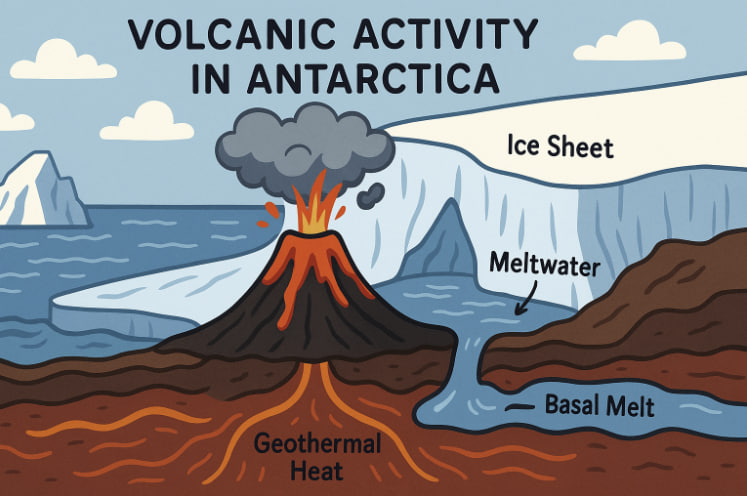While Antarctica is often imagined as a frozen, silent continent, it hides a surprisingly active geological landscape beneath its thick ice sheets. The continent is home to more than 100 volcanoes, including Mount Erebus, the southernmost active volcano on Earth. If volcanic activity in Antarctica increases significantly, it could have profound global consequences, affecting sea levels, climate, and even tectonic behavior.
Volcanoes Under Antarctic Ice
Most of Antarctica’s volcanoes are located beneath the West Antarctic Ice Sheet and are currently dormant or unknown in status due to inaccessibility. However, radar and seismic studies have revealed:
- Large volcanic systems beneath kilometers of ice;
- Heat flow and geothermal activity near known fault zones;
- Evidence that some subglacial eruptions may have occurred in recent millennia.
The thick ice acts as a lid, hiding many volcanic features and complicating monitoring efforts.
Potential Local Consequences
If volcanic activity increases:
- Subglacial eruptions could rapidly melt surrounding ice, creating lakes or rivers under the ice sheet;
- These meltwater systems can lubricate the ice sheet base, increasing the flow of ice toward the ocean;
- Ice loss in regions like the Thwaites Glacier could accelerate dramatically, raising sea levels;
- Volcanic gases like sulfur dioxide could be trapped or slowly released, affecting local chemistry.
Unlike eruptions in open air, those under ice don’t produce towering ash plumes — but their hidden effects can still destabilize ice structures.
Global Impacts of Antarctic Volcanism
A significant increase in volcanic activity could have broader consequences:
- Rising sea levels: Accelerated ice sheet collapse may add several centimeters — or more — to global sea levels;
- Climate feedbacks: The sudden influx of freshwater into oceans could disrupt thermohaline circulation, especially in the Southern Ocean;
- Ash and aerosols, if eruptions reach the atmosphere, could cool the planet temporarily — similar to the effects of volcanic winters.
Though Antarctic volcanoes are less likely to produce massive eruptions than those at plate boundaries, even localized activity can have planet-wide effects due to Antarctica’s central role in Earth’s climate system.
Is It Already Happening?
While no major eruptions have been recorded recently in Antarctica, studies show geothermal hotspots and signs of ongoing magma movement beneath the ice. Satellites and seismic instruments are increasingly used to monitor this remote area.
Some scientists believe that melting caused by climate change may, paradoxically, reduce pressure on magma chambers, possibly increasing volcanic activity — a phenomenon known as isostatic rebound.
Glossary
- Subglacial eruption: A volcanic eruption that occurs beneath a glacier or ice sheet.
- Isostatic rebound: The upward movement of Earth’s crust after the removal of heavy ice mass.
- Thermohaline circulation: Global ocean currents driven by differences in temperature and salinity.
- Geothermal heat: Heat from the Earth’s interior that can melt ice from below.
- Ice sheet collapse: A rapid loss of a large portion of an ice sheet into the ocean.


